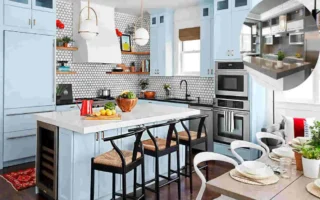When planning a kitchen remodel or new build, one of the most important choices is the type of material for your cabinets. The debate often comes down to two contenders: plywood kitchen cabinets and MDF (medium-density fiberboard) kitchen cabinets. Both materials are widely used in the cabinet industry, but each comes with its advantages and drawbacks.
In this guide, we’ll break down the key differences between plywood and MDF, helping homeowners and contractors make informed decisions. Whether you’re seeking durability, aesthetics, or cost-efficiency, understanding these materials will set your kitchen project up for long-term success.
What Is Plywood?
Plywood is made by gluing together thin layers of wood veneer, with the grain of each layer running perpendicular to the next. This cross-graining technique makes plywood strong and stable. It’s available in different grades and thicknesses, making it versatile for various cabinet components.
Pros of Plywood Kitchen Cabinets:
- Durability: Plywood is known for its strength and resistance to warping, sagging, and moisture.
- Lightweight: It’s lighter than MDF, which makes it easier to handle and install.
- Holds fasteners well: Screws and nails grip plywood more securely than MDF.
- Natural wood appearance: Plywood often has a more attractive, wood-like finish, which is ideal for visible cabinet interiors.
Cons:
- Higher cost: Quality plywood can be more expensive than MDF.
- Surface imperfections: Lower-grade plywood may have voids or knots, which can affect aesthetics if not properly veneered.
What Is MDF?
MDF is an engineered wood product made by breaking down hardwood or softwood residuals into wood fibers and combining them with wax and resin. It’s then compressed into dense, uniform panels.
Pros of MDF Kitchen Cabinets:
- Smooth surface: Ideal for painted cabinet doors and detailed profiles.
- Cost-effective: Generally more affordable than plywood.
- Stable: MDF doesn’t expand or contract as much as solid wood or even plywood, reducing the risk of cracks in painted finishes.
Cons:
- Heavier: MDF is denser and heavier than plywood, which can be a challenge during installation.
- Less moisture-resistant: It absorbs water more easily, making it unsuitable for areas prone to humidity unless properly sealed.
- Weaker screw-holding capacity: Fasteners can loosen over time.
Use Case Recommendations
For homeowners seeking cabinets that can endure high usage and last for years, plywood kitchen cabinets are a smart investment. Their durability and resilience make them ideal for busy kitchens, especially where moisture and heavy loading are common.
Contractors often choose plywood for structural components like cabinet boxes while using MDF for door panels or decorative finishes where intricate designs and smooth paint finishes are required.
If you’re balancing aesthetics and cost, a hybrid approach—plywood boxes with MDF doors—can offer the best of both worlds.
Environmental Considerations
Both plywood and MDF can be made from sustainable sources, but MDF often involves more chemicals in its production process. Formaldehyde emissions are a concern, so choosing certified low-emission products (such as CARB-compliant or E0 grade) is recommended.
Aesthetics and Finishing
If you’re aiming for a painted finish, MDF is the superior choice due to its smooth, consistent texture. For natural wood finishes or stains, plywood offers a more authentic and attractive grain pattern.
It all comes down to your design goals. If you want a classic wood kitchen look, plywood delivers. If you’re going for a sleek, modern painted aesthetic, MDF is your go-to.
Cost Implications
While MDF is initially more affordable, long-term durability must be factored into your decision. Plywood’s resilience often translates to lower maintenance and replacement costs over time. Think of it as a long-term investment in your home’s value.
Conclusion
The answer depends on your priorities. For strength, moisture resistance, and longevity, plywood kitchen cabinets win. For fine finishes and budget-conscious projects, MDF has clear advantages.
For homeowners and contractors looking for a trusted supplier and seamless design-to-installation process, OPPOLIA provides both plywood and MDF cabinet options tailored to your project.
OPPOLIA offers whole-house solutions; you can enjoy a one-stop shopping experience here. Visit OPPOLIA kitchen and choose us to be your trusted project partner. Contact us today to get a free quote!
You may aslo read (how to hide gaps in kitchen cabinets).




